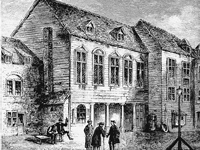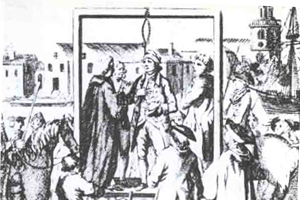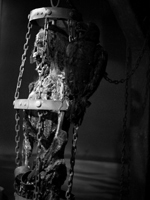
If you were to stand on the centre of Tower Bridge today, and glance to the east, your eyes would fall upon the site of East London’s most infamous hanging area – Execution Dock. Execution Dock was used for over 400 years by the Admiralty courts to execute pirates, smugglers and mutineers that had been sentenced to death. As the Admiralty was responsible for crimes that had been committed at sea (either abroad, or in home waters) the dock symbolised that jurisdiction by being located just beyond the low-tide mark in the river. The “dock” consisted of a scaffold and short rope for hanging, and was to be found off the shoreline of the River Thames at Wapping. The final hangings on Execution Dock were for two men called George Davis and William Watts. Both individuals were charged with piracy and were executed on December 16, 1830.
When an individual was charged with piracy they would be held in Marshalsea Prison in Southwark. The Marshalsea was an infamous private prison, located on the south bank of the River Thames.

From the 14th century until it closed in 1842, the prison housed a wide variety of prisoners, particularly men under court martial for crimes at sea and ‘unnatural crimes’. Any found guilty and subsequently sentenced to death by the Admiralty Court would be paraded from the prison over London Bridge, (Tower Bridge had not been built at this time), past the Tower of London and down towards Wapping where Execution Dock was located.
The procession of the condemned man would be headed by the High Court Marshal on horseback who carried a silver oar representing the authority of the Admiralty. Prisoners would be transported in a cart to Wapping, and they would be accompanied by a chaplain who encouraged them to confess their sins.
To reflect the severity of their crimes, the condemned were subjected to a cruel and lingering death. Unlike an execution at Tyburn, hanging would be done with a shortened rope. Instead of a long drop breaking a prisoner’s neck, he would suffer a slow and agonising death from strangulation on the scaffold. As the body twitched and jerked, onlookers who had lined the Wapping shore nicknamed the spasms ‘The Marshal’s Dance’.

It was not uncommon for onlookers to charter a boat on the Thames in order to get a better look of the hanging. The bodies of pirates at Execution Dock were not immediately cut down once the execution had taken place and it was customary for these corpses to be left hanging on the nooses until at least three tides had washed over their heads.
The infamous Captain Kidd, who had subsequently been convicted of piracy and murder, was executed at the dock in 1701. However, during his execution, the hangman’s rope broke and Kidd was actually hanged on the second attempt. His remains were tarred and were placed in an iron gibbet alongside the River Thames at Tilbury for years as a dire warning to any other potential pirates, as to what fate awaited them.
Whilst the modern day location of the actual scaffold of Execution Dock is a little hazy, a 1746 map shows the ‘Execution Dock Stairs’ at Wapping, whilst the present day sites of a building at Swan Wharf, 80 Wapping High Street, and a public house named ‘The Captain Kidd’ at 108 Wapping High Street are both strong contenders.
